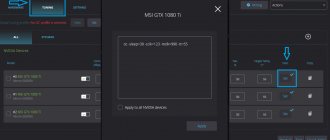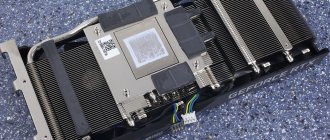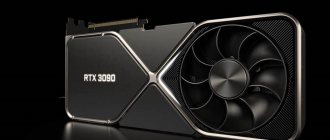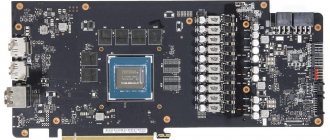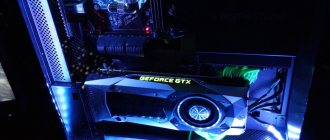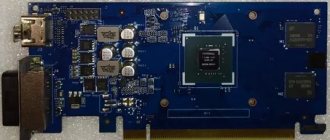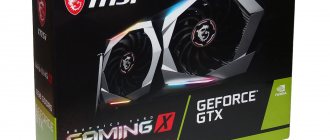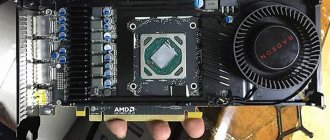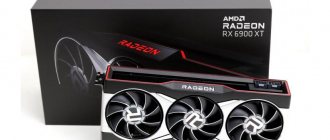We decided to combine articles on all three GeForce 16 series cards, since the cards are very similar to each other, and they have a common approach to tuning and overclocking. But we hasten to reassure you, you will see the exact characteristics of overclocking, consumption and profitability separately for each model in the series. In particular, we will analyze mining on 1660, 1660 Ti, 1660 Super. Let's compare them with each other. First of all, Ethereum mining is interesting. Let's look at the capabilities of video cards in mining ether and other coins using different algorithms, study the overclocking potential of the cards and how much can be added to profitability, overclock the cards and optimize energy consumption.
What to look for when buying an Nvidia GTX 1660 Super
What you can appreciate without opening the card packaging is the cooling system. Main rules when choosing cards:
- don’t take single-cooler stumps - you’ll suffer in the summer;
- there should be more than 1 copper tube on the heatsink of the card - I once bought a two-cooler from gigabytes - but there is 1 copper tube - in the summer 2 coolers were turned at 100% for all 3 months and heated the air in other video cards;
- Well, if they let you check the card in a store, ask to see the CPU Z and the memory vendor of the card - it’s better to take Samsung. Although Hunix and Micron also work well.
How to find out how many heat pipes a 1660 super card has
For example, consider the ill-fated 1660 from Gigabyte:
GIGABYTE GeForce GTX 1660 SUPER OC [GV-N166SOC-6GD 1.0] with 1 HEAT PIPE
Look at the photo of the product card or in the store itself - from the end you can see all the features of the cooling system, radiator, heat pipes, how thermal pads are laid, etc. The main thing is to know where to look.
Thermal photographs
All thermal images were taken under maximum load for a general overview and understanding of the cooling system with a slight overclocking of the core and memory.
Having installed the thermal camera on top, we see that the GPU temperature does not exceed 51 degrees - an excellent result.
Please note that the coolers do their job perfectly, the residual heat is dissipated and is not stored inside the card.
Having installed the camera from the back of the video card, where the backplate is located, we see that the GPU temperature does not exceed 51 degrees. Excellent result.
Please note that the GPU temperature would not be much lower if measured without the backplate.
Overclocking settings for Nvidia GTX 1660 Super on Samsung and Hunix memory
Actually, all the settings are in the screenshot, don’t forget to divide the memory frequency by 2 if you have Windows.
Screenshot of settings in HIVE OS farm with 1660 SUPER on SAMSUNG and HUNIX memory
- Core clock 1035
- Memory 2000 in Hive/Rave and 1000 in Windows on Samsung and -1004 Hive/Rave and - 502 in Windows on Hunix
- Power limit - 70 or maximum slider to the left
Nvidia GTX 1660 Super on Hynix 31.5Mh+. Testing the card from KFA2.
Characteristics of GeForce 16 video cards
First of all, let's look at the comparative characteristics between these video cards in the reference version, i.e. since they were released by Nvidia, without the intervention of third-party vendors.
| Characteristics | GTX 1660 | GTX 1660 Ti | GTX 1660 Super |
| Graphic Card | |||
| Release Date: | Mar 14th, 2019 | ||
| Generation: | GeForce 16 | GeForce 16 | GeForce 16 |
| Graphics Processor | |||
| GPU Name: | TU116 | TU116 | TU116 |
| Architecture: | Turing | Turing | Turing |
| Clock Speeds | |||
| Base Clock | 1530 MHz | 1500 MHz | 1530 MHz |
| Boost Clock | 1785 MHz | 1770 MHz | 1785 MHz |
| Memory Clock | 2001 MHz 8 Gbps effective | 1500 MHz 12 Gbps effective | 1750 MHz 14 Gbps effective |
| Memory | |||
| Memory Size | 6 GB | 6 GB | 6 GB |
| Memory Type | GDDR5 | GDDR6 | GDDR6 |
| Memory Bus | 192 bit | 192 bit | 192 bit |
| Bandwidth | 192.1 GB/s | 288.0 GB/s | 336.0 GB/s |
| Board Design | |||
| TDP | 120 W | 120 W | 125 W |
| Suggested PSU | 300 W | 300 W | 300 W |
| Power Connectors | 1x 8-pin | 1x 8-pin | 1x 8-pin |
Comparative table of characteristics 1660 vs 1060 Ti vs 1660 Super
We see that the 1660 lags far behind the older models of this line, 1660 Super and 1660 Ti. Both in memory and core frequency. This will have an impact on the result. Since we are most concerned about the results of mining ether on the 1660, 1660 Ti and 1660 Super, and for it the key role is played by bandwidth and memory frequency, in this coin the 1660 Super will prove to be much more interesting than the younger modifications.
The best and worst Nvidia GTX 1660 Super models
Nowadays, all cards have almost the same hashrate; we mostly come across cards with Hynix . In mining, the operating temperature of the card is also important. 3daynews conducted a temperature test of the 1660 Super line of cards - here are the results:
Temperature operating conditions of Nvidia GTX 1660 Super according to 3daynews.
Based on this test result, you can evaluate the cooling quality of a 1660 super card from a specific vendor and model. From personal experience I can say that the most problem-free cards were from Palit and MSI . But cards from GIGABYTE , especially with 1 copper tube, got very hot, the cooler was turned to 100% in the summer and other cards in the rig were heated. If possible, buy models with 2 or 3 coolers. Carefully read the reviews on the retailer’s website - the CSN has sorting by stars and statistics of calls to the service department for each product. Also very useful information.
Profitability of video cards 1660, 1660 TI, 1660 Super
Let's consider the profitability of these cards using various algorithms, because Ether may go away from video card mining in the next year, what can we switch our capacities to?
| GTX 1660 | GTX 1660 Ti | GTX 1660 Super | ||||
| Algorithm | Hashrate | Consumption (Power) | Hashrate | Consumption (Power) | Hashrate | Consumption (Power) |
| Ethash | 23.00 Mh/s | 80.00W | 28.00 Mh/s | 80.00W | 29.00 Mh/s | 90.00W |
| Ethash4G | 23.00 Mh/s | 80.00W | 28.00 Mh/s | 80.00W | 29.00 Mh/s | 90.00W |
| Zhash | 37.00 h/s | 90.00W | 39.00 h/s | 90.00W | 33.00 h/s | 90.00W |
| CNHeavy | 700.00 h/s | 90.00W | 650.00 h/s | 90.00W | 650.00 h/s | 90.00W |
| CNGPU | 1250.00 h/s | 90.00W | 1500.00 h/s | 80.00W | 1150.00 h/s | 90.00W |
| CryptoNightR | 520.00 h/s | 90.00W | 500.00 h/s | 80.00W | 0 | 0.00W |
| CNFast | 1100.00 h/s | 90.00W | 1100.00 h/s | 90.00W | 1100.00 h/s | 90.00W |
| Aion | 150.00 h/s | 100.00W | 160.00 h/s | 100.00W | 150.00 h/s | 90.00W |
| CuckooCycle | 3.80 h/s | 90.00W | 4.60 h/s | 90.00W | 4.30 h/s | 90.00W |
| Cuckaroo(d)29 | 4.40 h/s | 90.00W | 5.10 h/s | 90.00W | 4.30 h/s | 90.00W |
| Cuckarooz29 | 2.30 h/s | 90.00W | 2.70 h/s | 90.00W | 0 | 0.00W |
| Cuckatoo31 | 0.00 h/s | 0.00W | 0.00 h/s | 0.00W | 0 | 0.00W |
| Cuckatoo32 | 0.22 h/s | 90.00W | 0.22 h/s | 90.00W | 0.22 h/s | 90.00W |
| Beam | 14.40 h/s | 90.00W | 15.20 h/s | 90.00W | 14.10 h/s | 90.00W |
| RandomX | 530.00 h/s | 90.00W | 580.00 h/s | 90.00W | 530.00 h/s | 90.00W |
| NeoScrypt | 550.00 kh/s | 90.00W | 1050.00 kh/s | 90.00W | 0 | 00.00W |
| Octopus | 19.90 Mh/s | 80.00W | 24.70 Mh/s | 100.00W | 22.40 Mh/s | 100.00W |
| EquihashZero | 22.90 h/s | 90.00W | 22.80 h/s | 90.00W | 19.50 h/s | 90.00W |
| ZelHash | 24.50 h/s | 90.00W | 24.70 h/s | 90.00W | 22.00 h/s | 90.00W |
| KawPow | 10.70 Mh/s | 90.00W | 13.30 Mh/s | 90.00W | 10.70 Mh/s | 90.00W |
| ProgPow | 10.70 Mh/s | 90.00W | 13.30 Mh/s | 90.00W | 11.30 Mh/s | 100.00W |
| X25X | 3.10 Mh/s | 90.00W | 3.30 Mh/s | 90.00W | 2.90 Mh/s | 90.00W |
| MTP | 2.00 Mh/s | 100.00W | 2.00 Mh/s | 100.00W | 1.70 Mh/s | 90.00W |
| Verthash | 0.38 Mh/s | 80.00W | 0.39 Mh/s | 80.00W | 0.43 Mh/s | 90.00W |
Difference between 1660 vs 1060 Ti vs 1660 Super
BIOS firmware to increase the hashrate of Nvidia GTX 1660 Super - Hunix gives 35 Mh!
In the summer of 2022, a new BIOS was released for the Nvidia GTX 1660 Super - after flashing the cards, they began to issue 35 megahash instead of 31.7 megahash! But consumption also increased slightly - by about 10 watts. We do everything at our own peril and risk - the card can be “bricked” and void the warranty.
Topic on mining club.
Pros of flashing 1660 Super:
- Increasing the hashrate and profitability of the video card.
Disadvantages of flashing 1660 Super:
- An increase in power consumption by about 10 watts - and as a consequence an increase in the operating temperature of the card and heat generation (very important in summer);
- The factory warranty is lost;
- There is a possibility of breaking the card;
- Sometimes problems with the card may appear - for example, fans may not work correctly, the number of rejectors may increase, etc. But maybe everything is fine.
To sew or not to sew - decide for yourself. Here are the video instructions:
Hack 1660 Super for Mining | The video card has become even cooler | Tests Before and After Firmware 1660Super 35mh+. Firmware. Comparison of operating modes before and after.
Which gtx 1660 to choose for mining
Memory plays a special role in the mining of Bitcoin and other cryptocurrencies, so the low-end GDDR5 model will be the most unprofitable option. At the same time, the Ti and Super models initially show very similar performance, and the latter is also cheaper. But this was before the sharp growth of BTC, and now the situation with prices is completely unclear.
mining
option that will suit you in terms of price, and remember that in terms of performance they go in this order:
- 1660;
- 1660 Super;
- 1660 Ti.
Speaking of vendors, you should pay attention to proven brands that offer good cooling:
- MSI;
- Gigabyte;
- Palit;
- ASUS.
When purchasing, you should pay attention to the cooling system - it must be original and in 100% working condition. We will not go into the topic of choosing a video card for mining in 2022, but will only say that a 30-60 minute test in the FurMark donut will be enough to see the temperatures and general condition:
- the temperature should not rise above 70-75°;
- there are no artifacts on the screen;
- The fans are not very noisy.
Why GTX 1660 and 1660 Ti
We chose these video card models for two reasons. Firstly, they are relatively new, and not much time has passed since the devices went on sale. Secondly, the WhatToMine mining profitability calculator indicates incorrect hashrates - that is, the performance of video cards. Users of the 2Miners pool could not get the correct projected income and complained about this in our chats.
So we did two things:
- learned real hashrates from miners;
- collected them in a capacious table - along with other video cards and algorithms.
We recommend bookmarking the table. If you are a miner or planning to start mining coins, you will definitely need it.
Mining profitability on Nvidia GeForce GTX 1660
We figured out how many megahashes 1660 gives, but what about the profitability? In the table below you can see how much profit one card will bring per day. Data is presented as of August 2022. Current information can be calculated at whattomine.com.
| Cryptocurrency | Income in dollars per 24 hours | Cryptocurrency | Income in dollars per 24 hours |
| Ethereum(ETH) Ethash | $1.56 | Zano(ZANO) ProgPowZ | $0.74 |
| Nicehash-Ethash Ethash | $1.46 | Swap(XWP) Cuckaroo29s | $1.41 |
| Ravencoin(RVN) KawPow | $1.40 | Ycash(YEC) EquihashZero | $1.12 |
| Ryo(RYO) CryptoNightGPU | $1.52 | Equilibria(XEQ) CryptoNightGPU | $1.36 |
| Nicehash-KawPow KawPow | $1.23 | Conceal(CCX) CryptoNightGPU | $1.46 |
| BitCash(BITC) X25X | $0.86 | Nicehash-CuckooCycle CuckooCycle | $1.08 |
| EthereumClassic(ETC) Etchash | $1.11 | Beam(BEAM) BeamHashIII | $1.11 |
| Nicehash-Autolykos Autolykos | $1.10 | Aeternity(AE) CuckooCycle | $1.09 |
| Firo(FIRO) MTP | $1.59 | Flux(FLUX) ZelHash | $0.81 |
| Zclassic(ZCL) EquihashZero | $1.30 | BitTubeCash (TUBE) CuckooCycle | $1.15 |
| Ergo(ERG) Autolykos | $1.24 | BitcoinGold (BTG) Zhash | $0.74 |
Ethereum mining on 1660Ti, 1660 Super and 1660: overclocking cards
When overclocking video cards, pay attention to the manufacturer. If it's Samsung, you can increase the hashrate by 2-3 Mh/s more than on cards from other vendors:
- Overclocking performance of 1660 for Ethereum (ETH) mining. The stock card produces 20.3 Mh/s on air, while the power consumption is 95 watts. To overclock the card, you need to increase the memory frequency by 900 Mhz and set the power supply to 70%. If it is not stable, the power can be increased to 75%. You can also lower the core frequency by 200-500Mhz, this point needs to be tested depending on memory overclocking and consumption limit. After overclocking, the 1660 produces 4 Mh/s more.
- 1660 Ti overclocking performance for Ethereum (ETH) mining. With factory settings, the 1660 TI produces 23 Mh/s while consuming 95 watts. When overclocking the 1660 Ti for Ether mining, we raise the memory to the same 900 Mhz, and set the power limit to 75%. After overclocking, the 1660 TI produces 27-28Mh/s, consuming 110-115 watts.
- 1660 Super overclocking performance for Ethereum (ETH) mining. With factory settings, the 1660 Super produces 28 Mh/s while consuming 95 watts. When overclocking the 1660 Super for Ethereum mining, we raise the memory by 900-1300 Mhz, reduce the core frequency by 200-500 Mhz and set the power limit to 70-75%. After overclocking, the 1660 Super produces 32-34Mh/s, consuming 90-100 watts.
To increase the hashrate, you do not need to change the timings. Adjustment of memory and core frequency parameters when overclocking a GOU device is carried out using MSI Afterburner.
Setting options vary by memory manufacturer. The 1660 SUPER and 1660 Ti can have video chips from Samsung, Micron or Hynix. On cards with Samsung memory, the memory clock can be raised above +1000, while the core clock is either left at zero or driven to a slight minus (for example, -300).
Cards with micron memory are usually not overclocked in memory higher than +850, and the core is set to either 0 or a small plus (for example, + 50).
At first, 1660 cards with Hynix memory were considered a bad purchase option. Miners could not overclock them on ether to more than 26 Mh/s, and the miner who got 1660 Super graphics adapters with Hynix chips in the store immediately took them back, and if they could not be returned, he bitterly cursed his fate. But only on some models you can see the memory chips without removing the top cover.
In most cases, you need to buy a card, take it home and insert it into your computer. Then the Gpu-Z program starts and only then can you see what you got. However, craftsmen eventually found out that Hynix video memory does not mean a loss of profit at all. You need to set the AF memory frequency for this card to -1004 and it will produce approximately 31.7 Mh/s on Ether. Tested on two versions of Palit 1660 SUPER graphics adapters. In this case, leave the core at zero, and powerlimit +60. Raising the power limit has almost no effect on the hashrate, but it leads to increased power consumption and excessive heating of the graphics core. But with other mining algorithms, 1660 cards with Hyunix memory require a higher power limit, and sometimes even turning the core frequency to positive. With the settings for Ether on the BitTube coin and other MimbleWimble forks, you will not get the maximum hashrate.
To reduce 1660 Ti mining consumption, set the Afterburner Power Limit of the video card in the range from 60 to 75%. To reduce core voltage:
- Move the Core Clock slider all the way to the left.
- Click on the three-step graph at the end of the line.
- In the pop-up window, raise the beginning of the graph to the required core frequency value.
- Click Apply.
This will keep the voltage at 800 mV while increasing overclocking. However, sometimes the graphics adapter may not respond to changes in the Curve setting. If a particular gpu device has Samsung video memory chips installed, you are in luck. Video cards with memory from this manufacturer handle overclocking well and are easy to undervolt. But if the video card has Hyunix or Micron memory, it is not always possible to lower the voltage using an afterburner. Then try an alternative option.
You can further reduce the core voltage using Nvidia Inspector. The program is not suitable for all video cards and is incompatible with other overclocking utilities. To configure overclocking and voltage, specify in a text file located in the program folder.
- TIMEOUT /T – delay interval before starting the application;
- SET FAN= cooler rotation speed;
- SET VOLT= core voltage;
- SET TEMP= target GPU temperature;
- SET GPU – card id starting from zero;
- -setMemoryClockOffset: – memory frequency (0,0,400= +400 MHz).
- -setBaseClockOffset: – core clock.
Change the file extension to bat, create a shortcut and place it in the startup folder. The standard path is C:\Users\username\AppData\Roaming\Microsoft\Windows\Start Menu\Programs\Startup.
If the farm is unstable, you need to identify the problematic video card and increase the core voltage or reduce overclocking. If the memory frequency settings are too high, the software usually freezes, and overclocking the core leads to the rig stopping. The raisers may need to be replaced.
Overclocking mining and reducing power consumption
The average power consumption of GTX 16 series cards is 100 watts. The NvidiaInspector program will help reduce energy consumption. However, it is worth considering that the program is incompatible with some utilities that are used to improve productivity. Before overclocking your video card for mining, it is recommended to consider the following factors:
- the Palit 1660 Super card is within the power limit and does not consume more than 135 watts;
- 1660 super Hynix for mining, the optimal memory frequency will be -1004 and powerlimit +60;
- 1660 Ti on Afterburner Power Limit should be set in the range of 60-75%.
To increase the stability of the farm and balance the power phases of video cards, you can use DCR smart controllers.
Mining Nvidia using the Kawpow algorithm
The Kawpow algorithm, the main currency of which is RVN, has quite clearly burst into mining. To illustrate the growing popularity of the cryptocurrency, here is a graph of the Ravencoin hashrate on the 2Miners pool: over the month, the figure has increased approximately five times.
Ravencoin pool hashrate on 2Miners
At the same time, the RVN rate jumped more than 500 percent in thirty days. On February 20, 2022, it set a record at 28.5 cents.
Ravencoin price chart for the month
The algorithm still works even with video cards with 3 GB of memory, it is not capricious (and many capricious cards using other algorithms work reliably on kawpow), and the speed correlates well with the PL level of the cards. Finally, RVN coin is listed on many major exchanges.
Based on a combination of factors, this algorithm confidently ranks second in importance and profitability after Ethash for mining on video cards.
Miner Ravencoin
For Windows 10 systems, video cards with 4 GB or more memory are required. For Windows 7 and Rave OS, 3 GB of memory on the card is sufficient for now.
Overclocking video cards for the Kawpow algorithm
Setting up video cards for KAWPOW is quite simple.
- First of all, we determine at what frequency the memory , in steps of +25 MHz. We find the one on which the video card driver starts to fail, and move away from it 50 MHz down into a stable area.
- We find the core voltage at which we are satisfied with the power consumption of the card. The lower the voltage, the less the card consumes, and the lower the maximum speed. The dependence is disproportionate; usually, when consumption decreases by 25-35% of the nominal value, the speed drops by only 15-20%. This gives us unique opportunities to automatically overclock video cards over time for multi-tariff meters.
- We find the maximum stable core frequency - also up +25 MHz - and move away from it down 25 MHz.
Cryptocurrency miners
Fine tuning will give us 2-6% additional speed or 2-4% energy efficiency. Therefore, we will not dwell on it in detail in this article.
For all the secrets, come to our Telegram chat.
The most profitable mining algorithm for 1660 Super
The best coin to mine for 1660 Super is Etherium. The optimal overclocking of the 1660 Super for Ether mining in MSI Afterburner is as follows:
- core frequency - do not change;
- memory frequency - increase to +1000 MHz;
- energy consumption limit - reduced to 76%;
- temperature limit - reduce to 70%.
After overclocking, you need to start mining cryptocurrency in MSI Afterburner and evaluate the process within 30 minutes. Then measure the parameters in MSI Afterburner and save them. Repeat and retest. In some cases, you will have to experiment with memory frequency, temperature and power consumption limits to achieve optimal results. It is recommended to reduce Memory Clock by 50 units during the setup process.
